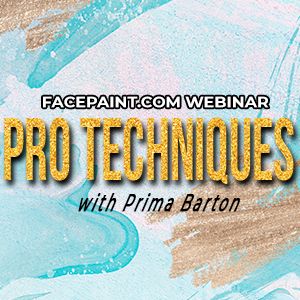In this webinar, learn T-Shirt Airbrushing Art with Eric Stiles.
Things You Need to do T-Shirt Airbrushing:
Easel
You will need a very sturdy, aluminum, strong easel. You don't wanna start doing t-shirts when you've got the very flimsy wood easel. You wanna have something that's kinda strong. Sometimes when you're outside, you'll get a good gust of wind and it can kinda move so you want to make sure you've got something that's got a little bit of weight to it so it doesn't blow away or tip over because sometimes you want to put your airbrushes on the little rail system so you wanna make sure it's nice and strong for that. So that's number one.
Airbrush
There are so many different types of airbrushes that a person can get but when it comes to doing t-shirts, I definitely recommend that you use what's called a Double Action airbrush. With a Double Action airbrush, it has the trigger up top and what the trigger does is it rocks back and forth to adjust the amount of paint that's coming out. So when you push down, air comes out. When you push back, more paint comes out. The reason I like it is because it gives you that much control right there. You don't have to adjust or do anything extra to get any extra paint. This particular airbrush is called a Vega 2000 by Thayer & Chandler. This is my baby. I just love the brand. It's shaped like a pencil. It's a Siphon-Feed airbrush.
If you have stubbier hands or maybe your fingers are a little bit thicker, maybe your hands are smaller, you may wanna try out what they call a Paasche VL. The body of it is a little bit thicker so it has a little bit more girth to it so you can wrap your fingers around it.
Airbrush Holder
This is an airbrush holder I actually grabbed from FacePaint.com. It's an 8-gun airbrush holder. It's wonderful. It's very thin, it's lightweight, it holds your airbrushes really great and it comes with a clamp so you can clamp it on different thicknesses. It does the trick all the time.
Manifold and Hoses
A manifold is something that you can use to connect multiple airbrushes to your compressor. So you can connect your red, your blue, your black, whatever. Each one of these connections is called a quick connect. Typically they don't really sell them with the manifold. You may have to go to your hardware store to get them. They're very common in your air compressor section. They have a male and a female unit which you just plug right in real quickly, real easily. Other than that, you have to kind of screw each one of the fittings in for each airbrush. This just makes it real easy when you're ready to go. They have different numbers of inputs on there so you can go 5-9. You don't have to use all of them but you never know what happens. You go on a gig and something happens to your hose, the kids step on it, or you sit on it with the chair and now it's no good so you need to quickly do another one.
Compressor
When I was young in the game, I had this big, loud compressor that I brought to an event and it was just super loud, so quiet is the game. I got this one from a hardware store called California Air Tools. It's a quiet compressor. This has a regulator and a gauge that shows you the amount of pressure that's building up. Typically I like to get between 40-60 psi when I'm airbrushing t-shirts. You can stick it under your table and if the DJ is going, it's hardly noticeable.
Moisture Trap
Moisture traps are really great because as your compressor is going on for a while, this helps pull some of that moisture out of the compressor before it sends it up back through your hoses to the airbrush to mess things up. You can grab them at the hardware store too.
T-Shirts
When I'm quoting a price, it's definitely a point to bring up as to who's gonna be responsible for getting the t-shirts. You can get different brands of t-shirts for very reasonable prices at a wholesale place or wherever you can get the best deal on your shirts. I even get Bella+Canvas t-shirts which are very, very nice quality shirts from wholesale. It'll be less and less and less depending on what brand of t-shirts you get.
I like to do only on white shirts. Typically you're gonna get people that are gonna request you do colored shirts. It's a little bit more difficult trying to make color pop out on darker colored t-shirts because you have to do a white under-base and then put the colors on top of there. If you can, try to see if you can steer the client to something very light. 100% cotton t-shirts are the best because they're gonna wick up that paint real quick. It's the claim to fame.
Paint
There is paint specifically for airbrushing. There's a company called Createx that sells both the opaque type of paint and transparent. When you're starting out, I would recommend to use opaque more so than transparent paint. You can also go to your local craft store and grab regular acrylic paint. However, airbrush paint is already ready to go.
If you need to thin it out a little bit, Createx has what's called a Reducer. It thins that paint down a little bit so that it flows a lot better through the airbrush. You can also use a Reducer with the regular acrylic paint. You have to thin it and strain it. Get a strainer, pour the paint through and in a bottle. Sometimes acrylic paint has little dry particles and that strainer will catch it. And then it's good to go for your airbrush.
Airbrush Cleaner
Airbrush has a cleaner solvent when you're dealing with acrylic paint so make sure you grab some airbrush cleaner.
Practicing T-Shirt Airbrushing
Paper towel is your friend when it comes to practicing because you can practice forever on it. The reason I do paper towels is because it's comparable to the texture of a t-shirt so if you're spraying too hard and too much paint is coming out of the airbrush, it's gonna be the same thing on a t-shirt. They kind of wick up just about the same capacity and the same amount of time so it's a good practice medium to work with while you're trying some things out.
We want to work on some techniques to help you build up your hand strength and your ability to do a range of different things as far as design.

So the first thing we want to work on is dots. We're working on the ability to do different sized dots and different opacities with the dots. So you want to be able to learn how to control it to do small dots, medium-sized dots, big dots all with the same airbrush. Just a matter of just moving the trigger back at a different point so you're able to master that.
Once you do your dots, then we're gonna work on lines. I'm gonna do thin lines, thicker lines like that, and very thick lines. All these things you want to be able to learn how to control and do at any given moment when you're doing your designs. Working on your thin lines can help you with your lettering.
The next part is what's called a dagger stroke. Dagger stroke is a term in airbrush that's just like in face painting, when we're going from thick to thin. So what I would do is take a little ruler and make a couple little lines for us to practice on a little bit of space. I'm starting all the way back with a lot of paint and I'm gradually gonna move my finger forward and I'm shutting off the amount of paint that's going out of there. So you want to be able to go from thin to thick.
Practicing your dagger strokes sets you up for doing things like your stars and other little embellishments, different designs and stuff like that for your shirts.
Products Mentioned in the Webinar:
Thayer & Chandler Vega 2000
Paasche VL
ProAiir Airbrush Holder (8-Gun)
California Air Tools Compressor
Paasche Compressors
Bella+Canvas White T-Shirts
Gildan White T-Shirts
Hanes White T-Shirts
Createx Opaque Paints
Createx Transparent Paints
Createx Reducer
Teflon Tape
Mylar
For a more in-depth discussion about t-shirt airbrushing, you can watch the full webinar above now or later on our YouTube channel.
Thank you, Eric, for sharing your talents with us! Thank you to everyone who tuned in to the webinar. Click here to know our upcoming webinars.
 FREE SHIPPING FOR USA ORDERS OVER $100
FREE SHIPPING FOR USA ORDERS OVER $100








Leave a comment (all fields required)